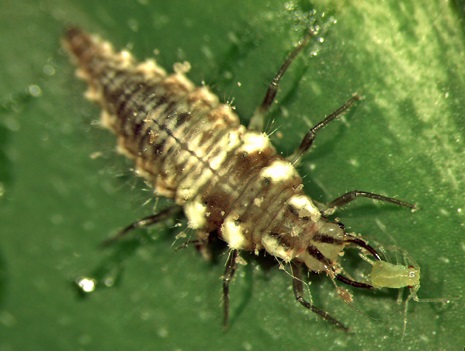In this series of articles, Growers Network discusses a few beneficial organisms you can use to aid your Cannabis grow. Today’s Topic: Lacewings.

Hello again! How’s your crop? I hope it’s doing well and you’re not dealing with any major pest issues. If you are however, have you considered including beneficial organisms to your pest management program? Well that’s what we’re talking about today, specifically the insects commonly called “lacewings.” These little helpers are great for battling aphids and spider mites organically. Read on!
Quick Look:
- Scientific Name: Over 1300 species of the family Chrysopidae
- Common Name: Lacewings (lacewing larvae are also referred to as “aphid lions” or “aphid wolves”).
- How They Help: Larval lacewings prey on aphids and spider mites. Adults also prey on these to a lesser extent.

More on Lacewings
Most lacewing species used as pest control are classified in one of two genera: Chrysopa and Chrysoperla. These insects are common in North America and Europe and may be a natural part of your operation already. However, you can purchase lacewings yourself and boost their numbers.
While adult lacewings will supplement their diet of pollen and nectar with aphids and spider mites, larval lacewings are the real predators. Sometimes referred to as aphid lions or aphid wolves, these larvae hatch and immediately molt before climbing the nearest plant to begin hunting for pests. In addition to the spider mites and aphids, these larvae will eat any soft-bodied arthropod they can sink their mouthparts into.
Writers Note: Larval lacewings have been known to bite fingers, so be careful!

Consider yourself lacewing literate! Beneficial organisms are a great addition to your pest control regimen, especially when we’re talking about Cannabis, a consumable crop that many patients depend on for relief. The last thing a sick person needs is to inhale chemical pesticides.
Did you like this article? Check out the rest of our profile articles on pests, diseases, conditions, and beneficials! Did we miss one? Leave a comment in the survey below, or better yet, join our forum and start a conversation. Happy growing!
10 Best Gift Ideas for Cannabis Connoisseurs and Growing Aficionados (2022)
December 7, 2022Developing and Optimizing a Cannabis Cultivation System
December 14, 2021Dealing with Insomnia: How Can CBD Help?
December 10, 2020Your Guide to Sleep and CBD
December 7, 2020
Do you want to receive the next Grower's Spotlight as soon as it's available? Sign up below!

About the Author
Chris DeWildt is a graduate of Grand Valley State University and Western Kentucky University. He worked in education and publishing for ten years before joining the team at Growers Network.
